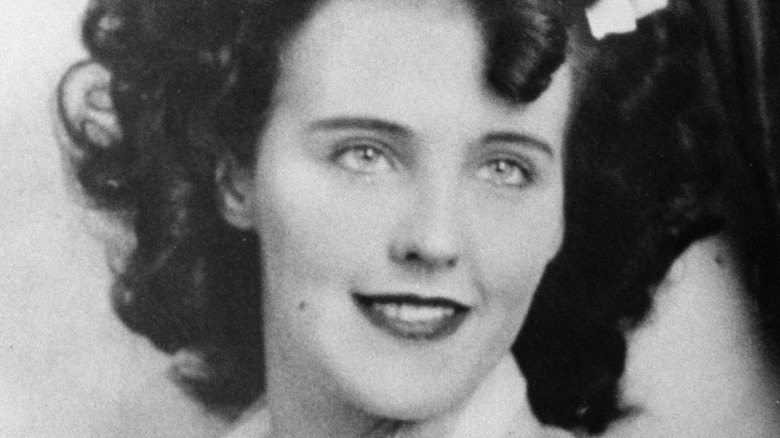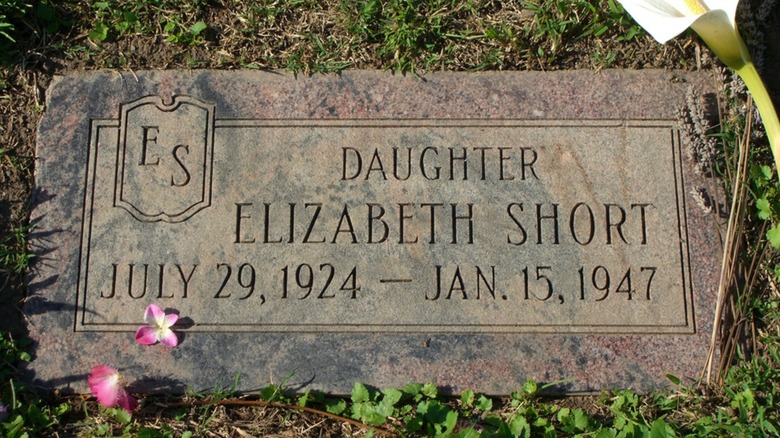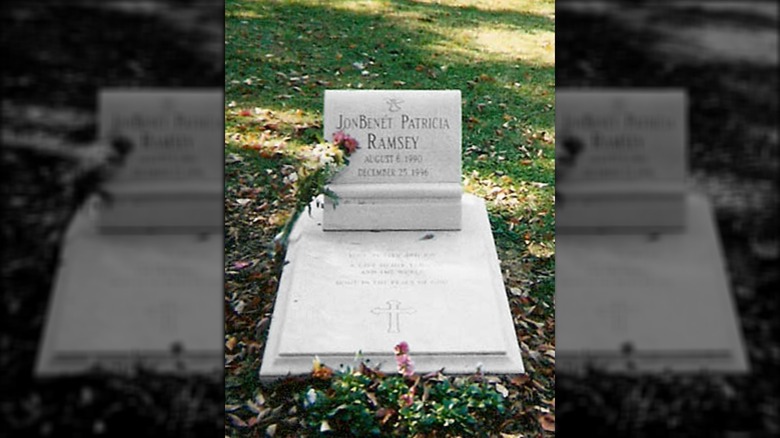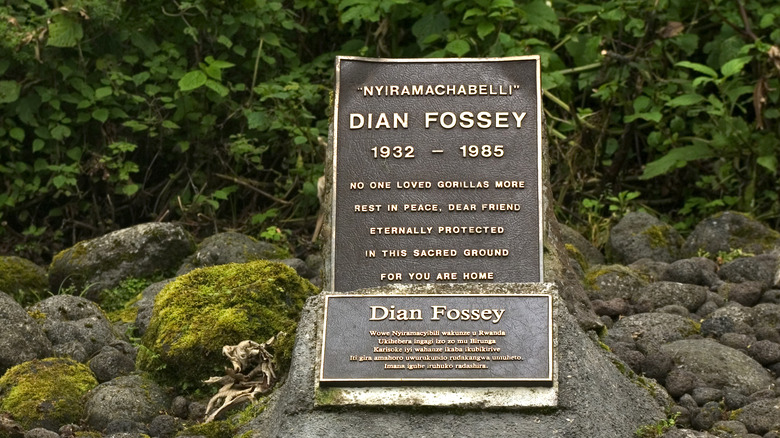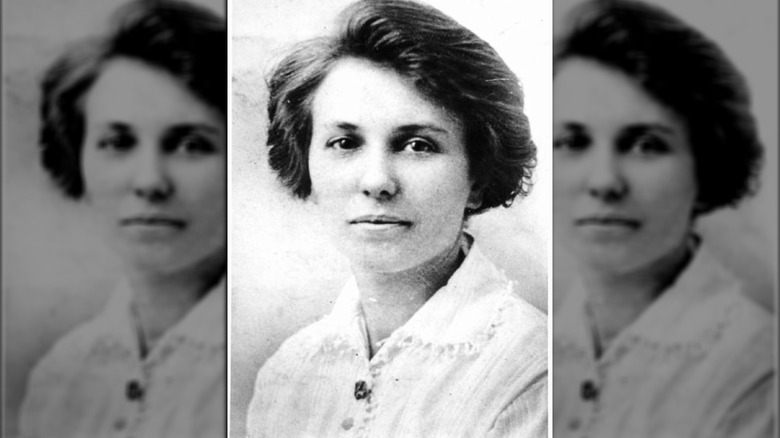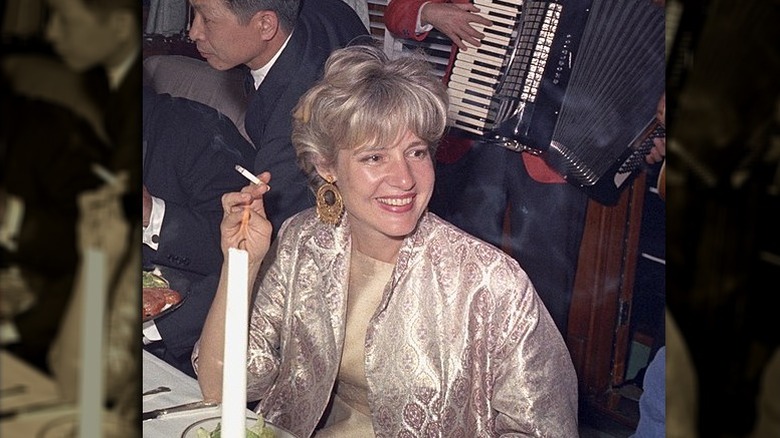Famous Murders That Remain Unsolved
Despite what television would have you believe, not every murder is solved in under an hour. No matter how much effort police put into the cases at the time and amateur sleuths do afterward, some murders will never be solved.
That's not to say that all unsolved murders are created equal. For some, almost everything about the case is unknown: the culprit, the victim's identity, the method, the motive. On occasion, the best the police can tell the public is that someone was definitely killed, but anything after that is nebulous. With other cases, everyone knows who did it, but they managed to get acquitted or gave the police an alibi. In still others, the only reason that witnesses aren't pointing fingers at the culprit is that these fingers will be immediately cut off — along with their heads.
However, for what little good it did for the victims, sometimes being unable to solve a murder drives those left behind to improve the world so that no one else has to suffer the same fate.
Elizabeth Short: The Black Dahlia
Elizabeth Short was an aspiring actress who moved from Massachusetts to L.A. to make it big at 19, according to CNN. However, her only starring role was in the nightmares of the people who found her body in Leimert Park in Hollywood on January 15, 1947. Short had been murdered somewhere else and dumped there intentionally, and the best thing that could be said is that the scene was bloodless. Rebel Circus details how she had been cut in half and her face had been brutalized.
It is unclear how she acquired her moniker of "Black Dahlia," if it came from her dark hair and tendency toward black, lacy clothing while she was alive or if it was something that the media came up with after her murder. The press of the time tried to claim the murder was a consequence of her sexual looseness, with some papers going so far as to imply that she had been a sex worker. It was later revealed that Short had a genital anomaly that would have made normal intercourse impossible.
Accusations went all the way to actor Orson Welles, who had allegedly paid off rape charges in the past and may have slain Short owing to his "diphasic personality" and because a mannequin resembling her is bisected in his film "The Lady from Shanghai," according to author Mary Pacios (via CNN). Around 50 people claimed that they killed Short, generally hoping to cash in on the attention or due to mental illness.
JonBenét Ramsey: Slain child beauty queen
On Christmas morning 1996, John and Patsy Ramsey could not find their six-year-old daughter JonBenét, a child beauty pageant winner. According to Time, after a frantic search of their Boulder, Colorado, home, Patsy found a handwritten three-page ransom letter demanding $118,000 for JonBenét's safe return. However, it was much too late for that. Hours later, John found his daughter strangled in the basement.
Scrutiny immediately fell on the parents. The ransom letter was too unusual, and the motivation for trying to ransom an already murdered girl was too strange, especially since ransomers could have demanded much more from JonBenét's wealthy, well-connected parents.
The Ramseys were cleared of the charges. To the Denver Post, Patsy said, "I'm appalled that anyone would think that John or I would be involved in such a hideous and heinous crime." John declared finding the killer his "sole mission" and wanted them to get the death penalty. The family offered a $100,000 reward to this end. In the same interview, they emphatically denied that anyone in the family had molested JonBenét and expressed their resentment that so much police energy went into examining them rather than other potential killers.
According to Rolling Stone, other suspects were a drifter, an electrician, and a man who played Santa Claus. A former teacher and convicted pedophile, Mark John Karr, confessed in detail in 2006 to having killed JonBenét. The police investigated his confession but soon dismissed Karr as a lying attention hound.
Amber Hagerman: Be alert
Even if you've never heard the name Amber Hagerman, you've likely received an Amber Alert.
According to KIRO 7, on January 13, 1996, nine-year-old Hagerman was abducted shortly after leaving her grandmother's house to ride her bicycle around an abandoned parking lot in East Arlington, Texas. It took four days for her body to be found in a creek bed miles away, her throat slit, according to True Crime Files. The New York Times reported that heavy rains had caused her body to be swept further downstream from where it had initially been sighted.
Despite a $10,000 reward that stands to this day and more than 7,000 leads investigated, there have been no credible ones. A member of the original task force, Sgt. Ben Lopez, stated, "All this time, we've only had one witness," a 78-year-old neighbor, Jimmie Kevil, who saw Amber grabbed by a white or Hispanic man in a black pickup truck. Police suspect that there might have been other witnesses who declined to speak to them, fearing deportation. Detective Grant Gildon, a lead investigator on this case, checks yearly to see if there is any technology that could crack the cold case.
The police believe that the killer kept Hagerman alive for at least two days. Had people known that Amber was missing and what she looked like, she might have been found in that window. This tragedy inspired the creation of the Amber Alert, and over 1,000 children so far have been saved as a result.
Villisca Ax Murders: the killer is in your attic
As a website about the murders explains, on June 13, 1912, two adults and six children in Villisca, Iowa, met their ends in the Moore home via an ax belonging to the father, Josiah Moore. According to Smithsonian Magazine, the killer then covered their ruined faces with clothing before concealing every mirror or exposed glass with cloths.
The townspeople went into an appropriate state of paranoia, adding locks to doors and carrying weapons everywhere. They all suspected each other, even though it was difficult to imagine that any of their neighbors were capable of this savagery. Police interviewed hundreds, but it came to nothing concrete.
According to the Villisca murders website, the suspects included Josiah Moore's former boss, Iowa state senator Frank Jones, enraged that Moore had opened his own business — and was possibly sleeping with Jones' daughter-in-law. Aside from Jones was a reverend who went insane, a random drifter, and a cocaine-addled serial killer for hire named William Mansfield. The last man is a promising culprit, as he allegedly murdered his wife, baby, father-, and mother-in-law two years after the Villisca murders. If not him, there was another serial killer, Henry Moore (no relation), in the area. He was convicted of killing his mother and grandmother with an ax months after the Villisca murders.
Whoever the killer was, they took their secret to the grave. Restored to its original condition, the home is now on the National Registrar of Historic Places and is open for tours.
The Chicago Tylenol murders: do not live if seal is broken
The Chicago Tylenol murders changed your life if you've ever fumbled with the cover reading, "Do not use if seal is broken." It is a crime that one could picture the Joker doing, as there seem to be few sensible motives.
The New York Times reports that, in 1982, someone refilled capsules of Extra-Strength Tylenol with potassium cyanide. The first to die was a 12-year-old named Mary Kellerman, and six more died before Johnson & Johnson could issue a recall, the first ever done. Copycats around the country caused more deaths in the meantime. According to PBS, Johnson & Johnson lost over $100 million recalling around 31 million bottles but were applauded for regaining the trust of a panicked public. To reassure consumers, they changed their packaging, and other businesses followed suit.
There was never a motive, though a tax consultant, James W. Lewis, sent a letter saying that he would "stop the killing" for $1 million. Though he was arrested and imprisoned for 12 years for extortion, he was not the culprit. No one credible ever came forward to claim that they had done this. ABC reported in 2011 that the FBI did take DNA from Ted Kaczynski, the Unabomber, as he was in the right place at the right time, and subverting a massive company would fit his M.O. However, it was another dead end.
Dian Fossey: murderers in the mist
Dian Fossey was one of the most prominent voices for gorillas, having written "Gorillas in the Mist" about her experiences with the animals. According to History, inspired by Louis and Mary Leakey, she broke off her engagement and took up a life of wildlife preservation, using her prior work with children to help her gain the gorillas' trust.
According to the BBC, she was found in her cabin in Rwanda, murdered with a machete. The killer knew where to find her bedroom, as they'd cut open exactly that wall. Given how she'd helped soften the reputation of gorillas and contributed to their preservation, it seems difficult to imagine who would have a grudge against her.
That is, People pointed out, it's difficult unless one reads more deeply about her. Fossey had something of a reputation. It has been claimed that she would kidnap and torture poachers while interrogating them, and she allegedly practiced black magic against those who would harm her gorillas, or at least pretended to. One theory posits that she was murdered by the family of a poacher whose sumu, a magical protection bag, Fossey had taken. Even if this did not prove to be accurate, she still made life difficult for antelope poachers and those who'd have liked to drive the gorillas further toward their death so that they could use the land.
Fossey was buried among her gorillas, her headstone bearing the Rwandese word for "the lady who lives alone in the forest."
Bob Crane: Hogan's Hero
Bob Crane was most famously known for his eponymous role in "Hogan's Heroes" — the only hit he ever had despite nearly two decades in the industry. AZCentral reports that his body was found in a Scottsdale, Arizona, apartment on June 29, 1978, his skull broken and an electrical cord wrapped around his neck.
Owing to the downturn of his career, Crane ended up working the dinner theater circuit, which brought him into a friendship with John Carpenter. The two would hook up with Crane's fans. Since Carpenter was always at the cutting edge of videography, Crane used him to make allegedly sometimes non-consensual videos of the sessions. That alone could give a jilted husband motive to end Crane's life, but one of the main suspects was Carpenter himself.
Carpenter was brought to trial in 1994, based on a speck on a photo that prosecutors said might have been fat from inside Crane's skull. The Phoenix New Times quoted Carpenter: "I never even had a fight with Bob, goddammit. He was my friend. And he was the goose who laid the golden egg for me, in terms of meeting ladies." In the end, the forensic evidence was too weak for conviction. The Scottsdale police had failed to secure the crime scene and even lost the supposed human tissue.
In 2017, a Phoenix television anchor wrote a book about the case: He had managed to analyze some blood found on Carpenter's rental car. It did not match Crane.
Alexander Litvinenko: radioactive tea
Alexander Litvinenko was a former lieutenant colonel in the Russian FSB before receiving political asylum in Great Britain after being charged with abuse of office. He was bold about making enemies of powerful people, such as telling Indymedia London that Vladimir Putin is "the originator of the acts of terrorism in London" and that the Russian special services engage in terrorism worldwide. When accusations against the Russian government come out of one's mouth, one must be careful what goes into it.
No amount of polonium is safe to have in one's body, but the dose Litvinenko received was unambiguous. He lived for three weeks after the poisoning. Whoever did this not only wanted to silence him but demonstrate what could happen to their enemies.
Dmitry Kovtun, an ex-KGB agent, told the BBC's Russian service that the accusation of his involvement was "completely absurd," though he was with Andrei Lugovoi, the chief suspect. The two met Litvinenko at the Millennium Hotel on November 1, 2006, when it is suspected that they spiked his tea with polonium, according to The Telegraph. After the murder, Lugovoi became a celebrity in Russia and was elected the MP of the Liberal Democratic Party.
Given the reach of the likeliest sources of his murderers, it is no surprise that the case has yet to be solved. Those who might have information are less likely to want to go public with it for fear that they could meet a similar fate.
Hall-Mills Murder: unfaithful under the tree
Time explains how a clergyman and choir singer were murdered in New Jersey in 1922: Dr. Edward Hall had one bullet wound. Eleanor Mills, his mistress, had three, and her throat had been cut. The killer had posed them under a crabapple tree, surrounded by tatters of their love letters. According to "Cold Cases: Famous Unsolved Mysteries, Crimes, and Disappearances in America," after they were murdered, the killer posed them with Mills' head resting on Hall's arm and her hand on his knee. Hall's business card was propped up on his shoe. An autopsy showed that they had been dead about 36 hours before discovery.
The crime scene was picked over by souvenir hunters when the case hit the press, hampering the ability of the police to find evidence — especially the murder weapons.
The star witness was Jane Gibson, who, by dint of raising pigs, was referred to as the "Pig Woman." She attested to having heard the gunshots and seen four people, two men and two women, one of the latter shouting "Henry." Returning later, she saw Hall's wife Frances weeping over her husband's corpse. A neighbor, A.C. Fraley, who lived across from the scene, heard nothing, nor did her boarders. Gibson lied.
Among the suspects were a case of mistaken identity by a jealous lover, Frances Hall and her brothers, or her cousin Henry Carpender. That Mrs. Hall sent clothing to be dyed black around the time of the double murder increased suspicion. All suspects were eliminated or acquitted.
Mary Pinchot Meyer: slain by the CIA?
According to Smithsonian Magazine, on October 12, 1964, two men heard a shot nearby, a cry for help, and then another shot. They claimed to have found a Black man standing over Mary Pinchot Meyer's body.
The police located Ray Crump Jr. nearby, with wet clothing and a cut on his hand. He told them that his fishing pole had dropped, then that he was drunk and had fallen into the Potomac. When they investigated, they found his fishing pole safe at home. What they did not find — there or ever — was the murder weapon. Crump was acquitted owing to a lack of evidence. What would be his motive for killing an artist out for a lunchtime walk, which (per CrimeReads) she had taken to doing to process the murder of her former lover?
When Meyer died, few knew of the affair she'd had with JFK. Her ex-husband and CIA deputy director Cord Meyer stated that Mary was killed by "the same sons of b*tches that killed John F. Kennedy" because she knew "too much for her own good." It is a more captivating theory than that Crump had killed her out of nonspecific racial animosity. He was a mentally unsteady man who would have had a more challenging time with so efficient a killing, leading to speculation that he was a patsy. (Crump did go on to commit a series of rapes and arson.)
Conspiracy theorists were free to speculate, but no one else was ever charged. If the CIA was indeed involved, it's unlikely anyone will be.
Dorothy Jane Scott: slain by a telephone stalker
Dorothy Jane Scott, a single mother, had been plagued by a telephone stalker. According to The Lineup, he would say, "When I get you alone, I will cut you up into bits so no one will ever find you." Other times, he fawned over her. He was aware of what she was doing daily and once told her to go outside, where he had left a dead rose on her car.
The stalking came to a head on May 27, 1980, when she took a coworker to the hospital, bringing another coworker with them. When the coworker was released, Scott left to bring the car around. When she didn't, her coworkers went to the parking lot, where they saw her car speeding off. At around 4:30 a.m. the next day, the vehicle was found ten miles away, engulfed in flames but empty.
The Los Angeles Times reported that, a week later, the stalker called Scott's mother, telling her, "I've got her." The police could never trace the calls since the stalker hung up so quickly. After a story appeared in the Santa Ana Register, its editor received a call saying, "I caught her cheating with another man. ... I killed her," and the stalker knew details that hadn't been reported publicly.
Four years after she disappeared, Scott's charred bones were found in a ditch, at which point the stalker resumed taunting her family.
Lady of the Dunes: we're going to need a bigger suspect pool
The severely decomposed body of a woman was found in the dunes outside of Provincetown, Massachusetts, in July 1974. She lay nude on a beach towel, her hands cut off at the wrists with a pile of pine needles in their place. Several teeth had been removed as well, and her entire head had nearly been taken, as well. Beside her were her jeans and a blue bandana, neatly folded.
According to Celebrate Boston, no one could identify her despite police reconstructions and the fact that she'd had extensive dental work. In the 2010s, horror author Joe Hill, Stephen King's son, noticed an extra in "Jaws" who looked uncannily like the Lady of the Dunes, according to the Cape Cod Times. Regrettably, records for extras were not as assiduously kept then, so this was more a curiosity than a lead. CapeCodToday postulated that, given the method of mutilation, time, and place, she had been one of mobster Whitey Bulger's victims, but he never admitted to this.
According to CapeCod.com, serial killer Hadden Clark once confessed to murdering her, and it could fit his M.O. However, he also had paranoid schizophrenia, and his confession might be nothing more than his own wishful thinking in prison. Without even knowing who she was, there is a vanishingly slight chance that her killer will be brought to justice after all this time.
Hinterkaifeck Murders: get out of the house
Donaukurier explains that in March 1922, Viktoria Gruber, daughter of Andreas and Cäzilia Gruber, heard voices and footsteps in the attic. On the 30th, Andreas found that somebody had broken the locks of the barn. There were footprints in the snow going into the barn that did not come out. Friends advised Andreas to go to the police, but he was sure that he could defend his family.
The next day, the killer lured the family into the barn. Viktoria went first and received nine blows with a mattock. Each subsequent member left to find the one who had gone before. The baby and maid — who arrived that afternoon — remained inside, but the killer knew. He covered the bodies in the barn with hay, those in the house with blankets. The killer then remained for days, feeding the cows and eating all the bread from the pantry, according to Augsburger Zeitung.
Augsburger Allgemeine details that the police did not take fingerprints. The investigation was hindered by people interfering with the scene, going so far as to cook in the kitchen.
According to Hinterkaifeck.net, Viktoria and her father had spent time in prison, charged with incest, the year that her husband died at war, which could have given a killer motive. Viktoria had recently declined a marriage proposal, too. Many were accused, but none of the evidence was sufficient (via Hinterkaifeck.net). All the police knew was that the motive was not financial — no money had been taken.
Benny Evangelist: murdered cult leader and carpenter
Benny Evangelist was born in Italy as "Evangelista" and became known as a faith healer and self-described prophet before being murdered in Detroit in 1929. According to The Lineup, given his blasphemous gospel and unsatisfied customers, there was no lack of people who might have wanted him dead. How many hated him enough to pose his detached head next to him and also slay his wife and four children is another question.
The motive for the murder might not have been righteousness or revenge but greed. Evangelist was also a carpenter and had arranged to pick up a large load of lumber on the day he was murdered, intending to pay for it with cash. On account of being dead, he missed that appointment, but so did the people who were going to be delivering the lumber. How could they have known that Evangelist would not be there unless they had made him late? The money for this transaction was not found. Evangelist had not recorded these people's names, so the lead was a dead end.
Like all good unsolved murders, this one touches on black magic. According to American Hauntings, when he lived in York, Pennsylvania, Evangelist practiced the darker side of the occult with another Italian immigrant, Aurelius Angelino. This man went on to brutally murder his wife and children before being locked away in a prison for the criminally insane. Angelino escaped in 1923, time enough to get to Detroit and pay Evangelist a visit.
